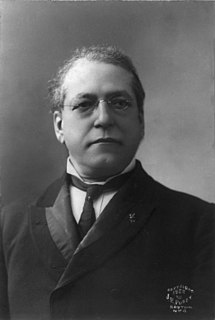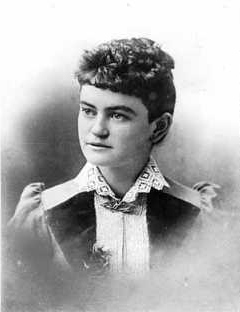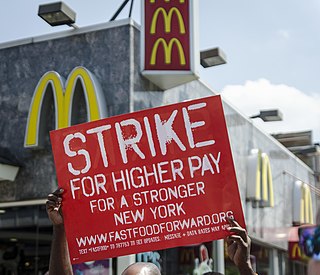
The Pullman Strike was two interrelated strikes in 1894 that shaped national labor policy in the United States during a period of deep economic depression. First came a strike by the American Railway Union (ARU) against the Pullman factory in Chicago in spring 1894. When it failed the ARU launched a national boycott against all trains that carried Pullman passenger cars. This action stopped most of the passenger and freight trains west of Detroit. President Grover Cleveland took action and obtained a federal court order against the ARU to stop the boycott. It refused and the boycott grew violent. Cleveland sent in the U.S. Army to successfully end the boycott and get the trains moving. The ARU was decisively defeated and its leaders, led by Eugene Debs, went to prison.

Samuel Gompers was a British-born American cigar maker, labor union leader and a key figure in American labor history. Gompers founded the American Federation of Labor (AFL), and served as the organization's president from 1886 to 1894, and from 1895 until his death in 1924. He promoted harmony among the different craft unions that comprised the AFL, trying to minimize jurisdictional battles. He promoted through organization and collective bargaining, to secure shorter hours and higher wages, the first essential steps, he believed, to emancipating labor. He also encouraged the AFL to take political action to "elect their friends" and "defeat their enemies". He mostly supported Democrats, but sometimes Republicans. He strongly opposed Socialists, and he was particularly opposed to immigrants from China, spreading racist arguments about their supposed inferiority. During World War I, Gompers and the AFL openly supported the war effort, attempting to avert strikes and boost morale while raising wage rates and expanding membership.

The American Federation of Labor (AFL) was a national federation of labor unions in the United States founded in Columbus, Ohio, in December 1886 by an alliance of craft unions disaffected from the Knights of Labor, a national labor union. Samuel Gompers was elected the full-time president at its founding convention and reelected every year, except one, until his death in 1924. He became the major spokesperson for the union movement.

The Federation of Organized Trades and Labor Unions of the United States and Canada (FOTLU) was a federation of labor unions created on November 15, 1881, at Turner Hall in Pittsburgh. It changed its name to the American Federation of Labor (AFL) on December 8, 1886.
The Journeymen Cigar Makers' International Union of America (CMIU) was a labor union established in 1864 that represented workers in the cigar industry. The CMIU was part of the American Federation of Labor from 1887 until its merger in 2003.

The Great Railroad Strike of 1877, sometimes referred to as the Great Upheaval, began on July 14 in Martinsburg, West Virginia, after the Baltimore and Ohio Railroad (B&O) cut wages for the third time in a year. This strike finally ended some 69 days later, after it was put down by unofficial militias, the National Guard, and federal troops. Because of economic problems and pressure on wages by the railroads, workers in numerous other cities, in New York, Pennsylvania and Maryland, into Illinois and Missouri, also went out on strike. An estimated 100 people were killed in the unrest across the country. In Martinsburg, Pittsburgh, Philadelphia and other cities, workers burned down and destroyed both physical facilities and the rolling stock of the railroads—engines and railroad cars. Local populations feared that workers were rising in revolution such as the Paris Commune of 1871.

The 1913 Paterson silk strike was a work stoppage involving silk mill workers in Paterson, New Jersey. The strike involved demands for establishment of an eight-hour day and improved working conditions. The strike began in February 1913, and ended five months later, on July 28. During the course of the strike, approximately 1,850 strikers were arrested, including Industrial Workers of the World (IWW) leaders Bill Haywood and Elizabeth Gurley Flynn.

Por Larrañaga is the name of a cigar brand produced in Cuba for Habanos S.A., the Cuban state-owned tobacco company, as well as a non-Cuban line of cigars produced in the Dominican Republic and Honduras for Altadis, a subsidiary of Imperial Brands. Por Larrañaga cigars have been in continuous production in Cuba since 1834, longer than any other Cuban cigar brand.
Labor federation competition in the United States is a history of the labor movement, considering U.S. labor organizations and federations that have been regional, national, or international in scope, and that have united organizations of disparate groups of workers. Union philosophy and ideology changed from one period to another, conflicting at times. Government actions have controlled, or legislated against particular industrial actions or labor entities, resulting in the diminishing of one labor federation entity or the advance of another.
"The labor problem" is the economics term widely used toward the turn of the 20th century with various applications. It has been defined in many ways, such as "the problem of improving the conditions of employment of the wage-earning classes."

James Duncan was a Scottish American union leader, and president of the Granite Cutters' International Association from 1885 until his death in 1928. He was an influential member of the American labor movement, helping to co-found the American Federation of Labor.

The Railroad Labor Board (RLB) was an institution established in the United States of America by the Transportation Act of 1920. This nine-member panel was designed as means of settling wage disputes between railway companies and their employees. The Board's approval of wage reductions for railroad shopmen was instrumental in triggering the Great Railroad Strike of 1922. The Board was terminated on May 20, 1926 when President Calvin Coolidge signed a new Railway Labor Act into law.

Adolph Strasser (1843-1939), born in the Austro-Hungarian empire, was an American trade union organizer. Strasser is best remembered as a founder of the United Cigarmakers Union and the American Federation of Labor. Strasser was additionally the president of the Cigar Makers' International Union for a period of 14 years, heading the union during the period in which it introduced its successful union label and gained substantial organizational strength.

Eva McDonald Valesh was an American journalist and labor rights activist. Valesh was an activist for, and reported on conditions of laborers in Minnesota's garment factories. She was also a speaker for the Knights of Labor movement and the National Farmer's Alliance.

The Glass, Molders, Pottery, Plastics and Allied Workers International Union is a labor union which represents about 28,000 craft and industrial workers primarily in the ceramics, china, craft metals, fiberglass, glass, insulation, and pottery industries. It is one of the oldest unions in the United States, with its first locals formed in 1842.
The Tampa cigar makers' strike of 1931 took place in Ybor City, Tampa, Florida in the months of November and December. Some strikers were jailed, "Lectors" were banned and there was a lockout. Following legal intervention, some workers returned to work at previous wage levels but others were not re-employed. Lectors had by tradition been elected by the workers and, as well as reading aloud newspaper articles, often from left-wing radical publications, they recited and acted more generally, including from classic works – effectively they provided a form of education for illiterate workers. The most significant effect of the strike in the longer term was that the lector culture was brought to an end.

The Fight for $15 is an American political movement advocating for the minimum wage to be raised to $15 per hour. The federal minimum wage was last set at $7.25 per hour in 2009. The movement has involved strikes by child care, home healthcare, airport, gas station, convenience store, and fast food workers for increased wages and the right to form a labor union. The "Fight for $15" movement started in 2012, in response to workers' inability to cover their costs on such a low salary, as well as the stressful work conditions of many of the service jobs which pay the minimum wage.

Brown Brothers Tobacco Company was located at 119 State Street in Detroit. The building was built for brothers, Robert Hamilton Brown and John Brown who founded a cigar manufacturing business which was, at one time, the largest cigar factory under one roof in the world. Brown Brothers were known for the following cigar brands: Newsboys, Cremo, Fontella, Carmencita, Evangeline and Detroit Free Press.

The 1928 New Bedford textile strike was a mass work stoppage of approximately 30,000 machinery operatives in several of the large cotton mills located in New Bedford, Massachusetts, USA. The strike, which ran for several months during the spring and summer of 1928, is remembered for the prominent role played by the Workers (Communist) Party of America in mobilizing the immigrant workers of the region.
On July 7, 1919, roughly 2,100 of Boston's 2,400 cigar makers walked off the job in protest of their employer's failure to meet their demand of a 13 7/11% raise. Three of Boston's largest cigar manufacturers chose to leave the city rather than meet the union's demands and a number of union members formed a cigar-making co-operative. By August 30, 1919, all of the remaining manufacturers had reached agreements with the union.















